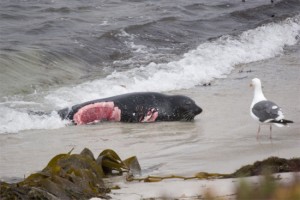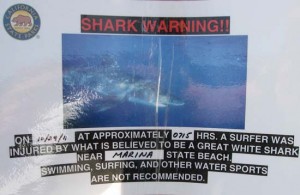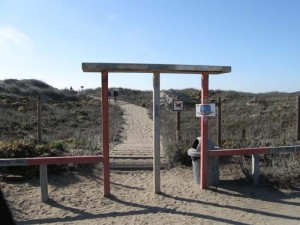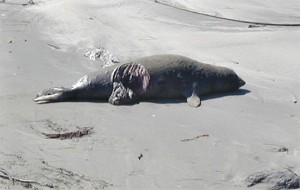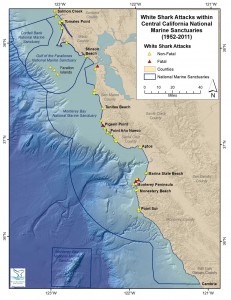
This article presents summaries of recent shark attacks and more general information about such incidents.
FACTS
- Shark attacks on humans are extremely rare events.
- White sharks (Carcharodon carcharias) are involved in most attacks within the central California region.
- White sharks are, on average, 15 ft long and can reach 21 ft, weigh up to 5000 lbs, live 20 yr or more, and swim up to 25 mph.
- Since 1952 there have been only 13 fatal attacks involving white sharks in California.
- The white shark (Carcharodon carcharias) is a large predatory species attracted to the region by pinniped (seals and sea lions) breeding sites found at the Farallon Islands, Point Año Nuevo and Point Piedras Blancas.
Although the primary reason for most attacks is a cause for much debate, it is believed that investigation is the background force behind most white shark encounters. Other common reasons also include mistaken identity and territoriality. White sharks in particular are visual predators with a high visual acuity making it unlikely that they would be unable to differentiate between a human and a prey item.
Results from research conducted at the Farallon Islands suggest that white sharks will inspect any floating object, first with a visual inspection and if this doesn’t provoke a reaction, the shark further investigates using its mouth, an exceptionally tactile instrument. Each tooth is equipped with pressure and position sensitive nerves that enable the shark to feel how their teeth flex as they bite. This means a bite is able to contain a vast amount of tactile and sensory information, a useful tool for an investigative animal with no hands.
The theory of investigative bites is further supported when taken into consideration that white shark attacks rarely result in human fatality despite the shark’s power; there were less than ten recorded fatal attacks in California from 1952 – 2007. When these attacks are compared to the damage an adult white shark can inflict on its prey during an all out attack, they are surprisingly gentle affairs.
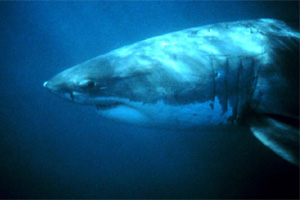
White sharks are a protected species and listed as vulnerable by the IUCN Red List, a database used by the International Union for the Conservation of Nature to catalogue and highlight those species that are facing a higher risk of global extinction. White sharks have been found to follow a predictable migratory cycle. Individuals in the genetically-distinct Northeast Pacific population persistently return to the same network of coastal hotspots (Tomales Point, Point Reyes, South East Farallon Island, and Año Nuevo Island) every fall and winter, before migrating toward focal areas off Hawaii and Baja California around the month of January. Recent white shark population research led by Taylor Chapple (UC Davis) and Dr. Barbara Block (Stanford University) off Tomales Point and the Farallon Islands used photographs of white shark dorsal fins to identify 130 unique individuals. A statistical model was then applied to estimate the total adult and sub-adult white shark population in the Central California region at 219. White sharks play an important role in maintaining the health of marine systems, and such research provides critical baseline data that will increase our understanding of natural population dynamics and anthropogenic impacts in the future.
Recent Shark Attacks in and adjacent to Monterey Bay National Marine Sanctuary:
08/19/2003 Avila State Beach, Deborah Franzman
08/28/2007 Marina State Beach, Todd Endris
10/29/2011 Marina State Beach, Eric Tarrantino
03/18/2017 Cannery Row, Brian Correiar, images of kayak damage, rescuer account and video
07/11/2017 Offshore of Steamer Lane, Steve Lawson bumped off his kayak, see article
11/24/2017 Offshore of Pebble Beach, near Stillwater Cove, spearfisherman was bitten while at surface, see article and follow up article
05/09/2020 Sand Dollar Beach, just south of Aptos, CA, Ben Kelly was fatally attacked while surfing
06/26/2021 Shark bites swimmer at Grey Whale Cove State Beach
12/24/2021 Morro Bay fatal shark attack, article
06/22/2022 Pacific Grove, shark bites swimmer at Lovers Point, news
Links to More Information
- “Shark incidents in California 1950-1921; frequency and trends” by Ugoretz et al. (2022)
- 2022: Shark bites increase following 3-year decline
- 2021: “A shark’s eye view: testing the ‘mistaken identity theory’ behind shark bites on humans”
- Statistics on California shark attacks
- 1926-2006 Map of California’s confirmed unprovoked shark attacks from the International Shark Attack File 1926-2006
- California Dept. of Fish and Game, white shark information page
- Tagging of Pacific Predators white shark page
- Summary of the census of white sharks
Images from central California
